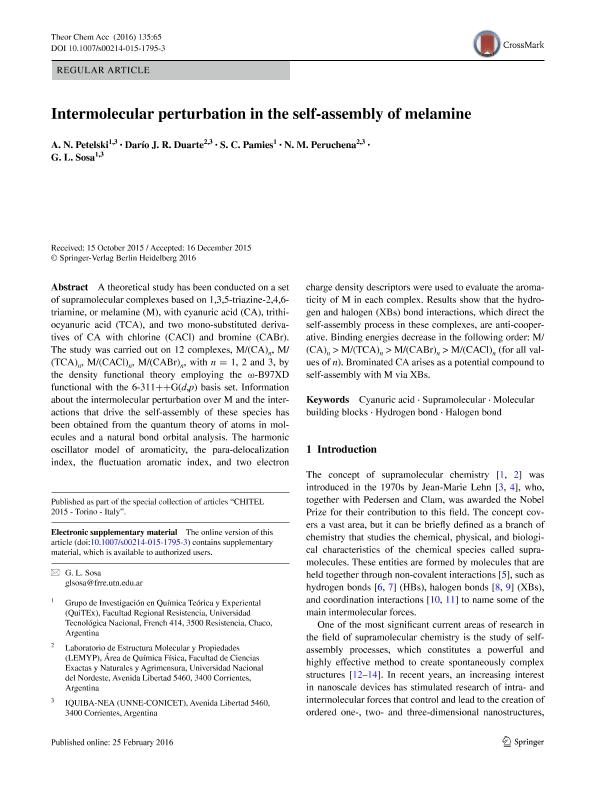Artículo
Intermolecular perturbation in the self-assembly of melamine
Petelski, Andre Nicolai ; Duarte, Darío Jorge Roberto
; Duarte, Darío Jorge Roberto ; Pamies, Silvana Carina; Peruchena, Nelida Maria
; Pamies, Silvana Carina; Peruchena, Nelida Maria ; Sosa, Gladis Laura
; Sosa, Gladis Laura
 ; Duarte, Darío Jorge Roberto
; Duarte, Darío Jorge Roberto ; Pamies, Silvana Carina; Peruchena, Nelida Maria
; Pamies, Silvana Carina; Peruchena, Nelida Maria ; Sosa, Gladis Laura
; Sosa, Gladis Laura
Fecha de publicación:
03/2016
Editorial:
Springer
Revista:
Theoretical Chemistry Accounts
ISSN:
1432-881X
e-ISSN:
1432-2234
Idioma:
Inglés
Tipo de recurso:
Artículo publicado
Clasificación temática:
Resumen
A theoretical study has been conducted on a set of supramolecular complexes based on 1,3,5-triazine-2,4,6-triamine, or melamine (M), with cyanuric acid (CA), trithiocyanuric acid (TCA), and two mono-substituted derivatives of CA with chlorine (CACl) and bromine (CABr). The study was carried out on 12 complexes, M/(CA)n, M/(TCA)n, M/(CACl)n, M/(CABr)n, with n = 1, 2 and 3, by the density functional theory employing the ω-B97XD functional with the 6-311++G(d,p) basis set. Information about the intermolecular perturbation over M and the interactions that drive the self-assembly of these species has been obtained from the quantum theory of atoms in molecules and a natural bond orbital analysis. The harmonic oscillator model of aromaticity, the para-delocalization index, the fluctuation aromatic index, and two electron charge density descriptors were used to evaluate the aromaticity of M in each complex. Results show that the hydrogen and halogen (XBs) bond interactions, which direct the self-assembly process in these complexes, are anti-cooperative. Binding energies decrease in the following order: M/(CA)n > M/(TCA)n > M/(CABr)n > M/(CACl)n (for all values of n). Brominated CA arises as a potential compound to self-assembly with M via XBs.
Archivos asociados
Licencia
Identificadores
Colecciones
Articulos(CCT - NORDESTE)
Articulos de CTRO.CIENTIFICO TECNOL.CONICET - NORDESTE
Articulos de CTRO.CIENTIFICO TECNOL.CONICET - NORDESTE
Citación
Petelski, Andre Nicolai; Duarte, Darío Jorge Roberto; Pamies, Silvana Carina; Peruchena, Nelida Maria; Sosa, Gladis Laura; Intermolecular perturbation in the self-assembly of melamine; Springer; Theoretical Chemistry Accounts; 135; 3; 3-2016; 1-13
Compartir
Altmétricas



